In August, Think Globally, Eat Locally
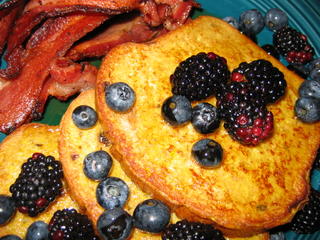 Jen over at Life Begins at Thirty brought my attention to the Locavores, and thier August Eat Local Challenge, which started as a site specific event in the San Francisco Bay Area, but has been taken up all over the country, and possibly the world, as the idea has spread over the Internet.
Jen over at Life Begins at Thirty brought my attention to the Locavores, and thier August Eat Local Challenge, which started as a site specific event in the San Francisco Bay Area, but has been taken up all over the country, and possibly the world, as the idea has spread over the Internet.
Well, here I am, throwing my gauntlet down into the ring and accepting the challenge. Which is kind of funny, mind you, because I try and eat locally anyway, but what the heck–this will give me an opportunity to get off my duff and actually do some of the things I have been meaning to do with this blog. You know, like interviewing local food producers, investigating the possiblity of making my own cheeses, and doing a bit of late summer canning with some of the wildly abundant produce at the farmer’s market, all of which, of course, will be chronicled here, because apparently, this sort of thing is interesting to other people!
In addition, I will do some reviews on books I have been reading on the subjects of eating locally and sustainably for the past few years and, of course, I will post recipes. And, some more essays on topics related to sustainability and local eating have been percolating in the back of my mind which are along the lines of my last rant, “Meat Comes from Animals….” which appears to have struck a nerve with folks.
But, for now, I am going to set down the guidelines for my own version of the August Eat Local Challenge, which I am setting myself.
Drum roll, please:
Guidelines:
I will attempt to eat as much locally produced food as possible during the month of August. I will shoot for one complete meal per day being totally local, with any other meals that are eaten locally as a bonus.
I will purchase as much of my meat and vegetables and fruits locally as possible, preferably from the Athens Farmer’s Market.
I will also purchase locally produced food from the local businesses which feature them, such as Big Chimney Bakery, The Village Bakery and Donkey Coffee. I will also purchase locally processed foods at the supermarket, which features an entire short aisle of local foods.
If I cannot get an item through truly local (Athens County, Ohio) sources, I will then attempt to buy Ohio products. Those products which I cannot get produced in Ohio, I will purchase organic or from small producers.
My own personal exceptions to local food are these: coffee, citrus, olives and olive oil, avocadoes and chocolate. In the cases of these items, I will buy as green as I can–organic, free-trade, and as much as possible, from small farmers and producers.
I also will make another exception for Asian ingredients like soy sauce, fish sauce and coconut milk. These things come from Asia, that is where they come from, and that is what I am going to use. I don’t have any issues with eating some imported products, so long as I am eating the bulk of my food, my staple foods–from local sources. Soy sauce never came from Ohio, so I don’t mind buying it from China. Apples, on the other hand, grow just fine here in Ohio, so I will be damned if I will buy them from China.
Do you see the difference?
And, finally, when we eat out, we will patronize local restaurants which feature products from local farmers. Casa Nueva is one such place, but there are others here in Athens.
And every last bit of it, I will record in this blog. If nothing else, maybe it will inspire other folks to get interested in trying the same thing, in small ways or large, in their own lives. I am thrilled to find out that my father-in-law has taken to seeking out farmer’s markets and locally produced meats and vegetables, as have a few of my other readers.
Knowing that I have spread the idea of sustainability a few other people makes me unbelieveably happy. If I can manage to inspire a few more folks along the way, well, then, that is great!
Oh, and while I am thinking of it–that picture of last night’s “breakfast-for-dinner plate”–every last thing on that plate is local, or organic. The bacon is from King Family Farms, the berries from two different farmers at the farmer’s market, the maple syrup is Sticky Pete’s, which is produced right here in Athens County and the eggs are from Bridlewood Acres. The bread is organic and from Crumb’s, a local cooperatively owned bakery. The milk is the only non-local major ingredient–and I used organic.
So far, I have had no luck in finding truly local dairy products, because apparently, no one in Athens county is selling raw milk. (It is against the law to sell raw milk products in Ohio for human consumption. You can drink milk from your own dairy animals, but you may not sell it.)
Tasty Tattoos
Zak is a good husband. He alerts me to all the good articles floating around in the blogosphere. This morning, when I should have been reading the New York Times food section, but was instead finding out that abortion clinic bomber Eric Rudolph was being sentenced to life in prison, he told me to check out the story on tattooed fruit.
Yeah, tattooed fruit.
In an effort to be rid of those damnable produce stickers, a process by which the information contained on those stickers is instead burned by a laser into the skin of the fruit, has been patented and will soon be evident in a grocery store near you.
Just to prove I am not a neo-luddite, after my cautionary statements on nanotechnology yesterday, I want to say this seems like a pretty good idea. Part of the reasoning behind it is to track produce from source to table–and since most food travels thousands of miles in between these days, that is a good idea. Food security depends on knowing where your food came from–stickers don’t cut it because they fall off or can be removed. If a batch of apples, for example, comes in, and they have been poisoned or cross-contaminated in some way–tattoos will help investigators figure out the source of the contamination easier by providing an easier trail to follow back to the source of the fruit.
So, there–not everything that the giant food corporations come up with is evil.
Just most of it.
Cooking Instincts vs. The Cookbook
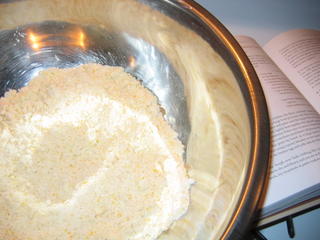 It all started, because we ate out at a new, or rather, new-to-us restaurant in town a couple of weeks ago. The food was pretty good, though I really wish that folks in Ohio would learn what al dente means when it comes to cooking pasta, and they had a dessert that sounded delightful–lemon blueberry tart.
It all started, because we ate out at a new, or rather, new-to-us restaurant in town a couple of weeks ago. The food was pretty good, though I really wish that folks in Ohio would learn what al dente means when it comes to cooking pasta, and they had a dessert that sounded delightful–lemon blueberry tart.
It sounded delightful, but Zak and I declined, because Zak pointed out that blueberries were in season, I knew how to make lemon curd and he bet that any tart I made would be better than what we paid too much for in a restaurant.
When he put the logic to me in that way, I couldn’t rightly disagree–especially since it meant that he trusted me to make a bang-up beautiful pastry all on my own in the kitchen.
And well, that is probably what I should have done in the first place. I should have just stuck to my usual instincts and made either a pate sucre crust or a batch of shortbread and pat it into a tart pan and call it a tart crust.
But no. I had to go and mistrust my own instinct and decide to get all fancy and follow a recipe out of a cookbook.
Without changing it as I went along.
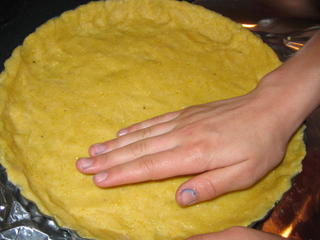 I really don’t know what possessed me to decide that actually following a recipe as written was a good idea, since I so seldom do that, but there I was. I had bought a quart of fresh blueberries and a dozen eggs at the farmer’s market and a bag of lemons at the grocery store. Butter, flour and sugar I had in the kitchen, so I trotted off to look up my pate sucre recipe, when my eye was caught by a book that I loved reading, but had never baked from.
I really don’t know what possessed me to decide that actually following a recipe as written was a good idea, since I so seldom do that, but there I was. I had bought a quart of fresh blueberries and a dozen eggs at the farmer’s market and a bag of lemons at the grocery store. Butter, flour and sugar I had in the kitchen, so I trotted off to look up my pate sucre recipe, when my eye was caught by a book that I loved reading, but had never baked from.
In the Sweet Kitchen: The Definitive Baker’s Companion by Regan Daley won the International Association of Culinary Professional’s prestigious Cookbook of the Year award in 2001, and with good reason. It is an excellent resource on dessert baking, and is chock full of facts, figures, tables and reference material that, while it may be available elsewhere, is not available all together in one volume.
Regan Daly is a young pastry chef who has worked at many of the finest restaurants in Toronto, and she really does know her stuff, and it is obvious by the way in which she writes.
So, I felt pretty comfortable taking that book out to see if she had a recipe for a lemon-blueberry tart. I figured a hotshot pastry chef is bound to know more about these things than I am.
And lo, and behold–there it was! A recipe for “Cornmeal Crusted Lemon Tart” that had a variation called simply, “Lemon Blueberry Tart.” I read the description of the dessert and my mouth watered: “a mouth-puckering, intensely lemony version of a classic bistro dessert…the cornmeal crust adds a rich nutty flavor and acts as a crunchy contrast to the sikly curd…the Lemon Blueberry Tart variation that follows is divine–these two flavors complement each other beautifully…but be sure you prepare it with fresh wild blueberries, or don’t make it at all!”
I had to cop to liking her attitude–insisting that your reader do the recipe your way or not at all appeals to me–not that I had fresh wild blueberries, mind you. I had fresh, locally grown cultivated organic blueberries, and figured that was good enough.
But it wasn’t the berries that gave me fits.
It was the crust.
I read the recipe, and read her method and thought about it. And something bugged me awfully much about it. It only had 1/3 cup of yellow cornmeal, preferably stoneground–but it also included baking powder, one large egg and one large egg yolk.
Daly warned in her description of how to put the recipe together that her tart dough turns out looking like dry, crumbly floury bits of weirdness and not like a proper dough at all. That gave me pause. She explained it away by saying that cornmeal takes a long time to assimilate liquids and that after the liquids soaked in a bit the dough would come together. She advocated putting the dough together in the food processor, but also gave a method for doing it by hand.
What really bothered me wasn’t crumbly tart dough–pate sucre can be crumbly and shortbread is intensely crumbly and looks like a disaster until you start patting it into its mold or the tart pan. It was the insistence upon the use of both an egg and an egg yolk that made me cagey. I was afraid that the eggs would make the tart dough too tough–which is probably why she added a single egg yolk in addition to the whole egg.
A little kitchen science to explain my wariness with this recipe: what causes pastry dough to be flakey and good is the way it is put together. The fat, in this case, butter, is cut into the flour–in this case, flour mixed with a very small amount of cornmeal–and then a scant amount of liquid is added–just enough to make the dough stick together.
Tart doughs are supposed to be somewhat stronger than regular pie dough, because after they are baked, they are removed from their pan to stand on a serving plate alone. The pie pan holds the crust of regular pies in shape–it is so flaky that it would crumble if it didn’t have the pie pan to give it structure.
The egg was obviously meant to help strengthen the tart dough, and I figured that the use of a single egg yolk in addition to the whole egg was meant to tenderize the dough by the addition of extra fat. The part of an egg which provides the most structural elements are the proteins in egg whites, while the egg yolk is mostly fat and water.
What was bothering me was this–not only was the dough going to have very strong structural elements–the crunch of cornmeal and the binding element of eggs, but it was also not rolled out, but instead, patted into the tart pan by hand.
I was fearful that all of this handling of the dough would make it tougher than it needed to be. The addition of the baking powder was obviously meant to lighten the pastry to some extent by providing a bit of lift, but I didn’t think that the amount she put in the recipe was really going to accomplish much.
I measured out the ingredients and almost chickened out and went for the shortbread crust instead. I figured I could use my shortbread recipe that includes ground almonds in it for the crunchy aspect of the cornmeal, and all would be well. I nearly did it, too, but my curiousity was too much for me. I had to know what that cornmeal crust tasted like.
And so, I followed the recipe, to the letter.
And the result was stunningly beautiful to behold: I have to toot my own horn here and say that the tart looked fantastic, which, really, anyone with eyes can see.
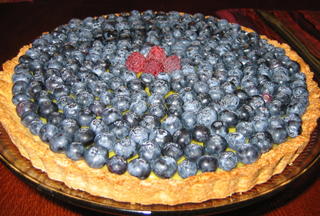 Making the crust was simple, and the lemon curd went together just as lemon curd goes together, meaning, I stirred and stirred the ingredients over a hot water bath for what seemed like an eternity of boredom, while nothing happened, when all of a sudden, it came together, thickened and became lemon curd.
Making the crust was simple, and the lemon curd went together just as lemon curd goes together, meaning, I stirred and stirred the ingredients over a hot water bath for what seemed like an eternity of boredom, while nothing happened, when all of a sudden, it came together, thickened and became lemon curd.
The blueberries with their garnish of fresh raspberries made a lovely presentation. Everyone oohed, aaahhed and drooled over it.
Until I went to cut the thing.
The crust, the beautiful golden crust, had turned into concrete.
I knew I hadn’t overbaked it. I had baked it at the right temperature. Morganna had very delicately patted it in the pan without handling it overmuch.
It had to be those eggs. And the cornmeal. And patting it into the crust made for just a bit too much handling.
After I managed to saw through the crust, and served the tart, people’s reactions were eloquent.
The cornmeal didn’t just add crunch–it added grit. Our dining room sounded like it was full of a bunch of cows chewing cud mixed with gravel. The lemon curd was beyond tangy into downright wicked puckery goodness, and the blueberries were perfect, a little sweet, a little tart and very lovely contrasting with the yellow lemon curd and golden crust.
But the crust was just way too tough, gritty and unpleasant, and it ruined the dessert.
It was a demoralizing lesson, but one I had to learn.
Now, I know, the next time I get an inkling that something may not work out, I will follow my instincts–even if they run counter to what the hotshot chef who wrote the book says to do.
That said, I have decided to follow my instinct and remake the tart this weekend, using my shortbread recipe that includes almonds. I will report upon the results and post the recipe when I get to putting it together.
Until then, folks can feast their eyes, if not their palates, on the beautiful picture of the tart that should have been divine, but instead had a crust of concrete. (Which is like my feet of clay, only crunchier and harder on the dental work.)
Cantonese Minced Chicken in Lettuce Cups
Summer is the perfect time of year to investigate dishes which emphasize light flavors, crisp textures, and use the produce from prolific vegetable gardens. Cantonese cuisine, which is known for its skillful use of minimal seasonings, its emphasis upon contrasting textures and flavors, and colorful, artistic presentation, is a natural fit to the summertime cooking looking for something new and different to present to family and friends.
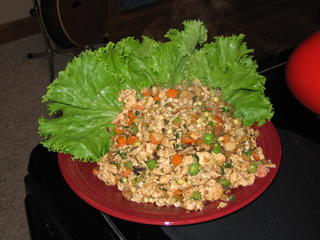
Having cooked similar Thai dishes, I was not intimidated by the thought of hand-mincing the chicken as I was directed to in Yan-Kit So’s cookbook, Yan-Kit’s Classic Chinese Cooking, but I decided to check out a couple of other cookbooks and synthesize my recipe from several sources, as well as my own experience eating the dish in one or two restaurants.
Not surprisingly, I found that there are probably as many different recipes for this dish as there are cooks in Canton; in my collection of Chinese cookbooks, I stopped seeking recipes to consult after I found nine variations on the typical dish.
Before I continue, I have to explain that Minced Chicken in Lettuce Cups is based upon a classic, luxurious Cantonese banquet dish, Minced Squab in Lettuce Cups. The original recipe includes oysters, and minced or finely diced pigeon meat, delicately seasoned and presented with lettuce leaves which diners used as wrappers for the rich filling.
It is hard for most Americans to think of eating pigeon meat without grimacing; even though the rock doves who live feral in our cities were brought here for human consumption, they have become at best nuisances and at worst, health hazards. They have an appalling reputation as dirty birds, in large part because of their eating habits which consist of eating whatever waste food is spilled on the ground or into dumpsters. I have even heard them called “winged rats,” or “air vermin,” by city-dwellers who have no patience with these ubiquitous birds.
However, suffice to say that our wild pigeons, while they are genetically the same as the rock doves raised for meat elsewhere in the world, are a far cry from what would have been considered a luxury meat in Canton. The domestic birds raised for the table in China were kept in clean dovecotes and were fed dainty diets, and so produced meat that was both delicately flavored and rich, and was truly fit to be paired with oysters.
The variant based on chicken came about as home cooks, street vendors and the proprietors of less exclusive restaurants copied the recipe using cheaper, more common ingredients. Chicken breast was an obvious substitute for squab, and while oysters were still used in some versions of the dish, often they were replaced with a touch of oyster sauce, or were left out altogether. While the original recipe was finely diced into minute cubes, the chicken version was most often made using meat freshly minced by hand.
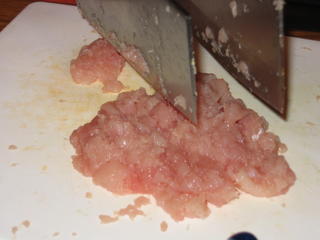 Mincing meat by hand can be accomplished using only one Chinese cleaver, but it is faster and more fun when the cook uses two cleavers, one in each hand. The technique is not only faster and easier, it never fails to look flashy and impressive, meaning that if you have guests who arrive early, you can entertain them with your expertise in wielding two large chunks of sharp metal.
Mincing meat by hand can be accomplished using only one Chinese cleaver, but it is faster and more fun when the cook uses two cleavers, one in each hand. The technique is not only faster and easier, it never fails to look flashy and impressive, meaning that if you have guests who arrive early, you can entertain them with your expertise in wielding two large chunks of sharp metal.
Basically, in order to mince boneless, skinless chicken breasts by hand, you start out by trimming away any membranes, tendons or fat from the flesh with one cleaver, held in your dominant hand, in the proper fashion. Then, you roughly dice the meat into 3/4 inch cubes, and set it all into a pile in the center of your cutting board. Then, rinse off your off hand, which has been used to hold the chicken, and dry it completely. Take up a second cleaver, which is as close in size and weight to the first cleaver as possible, and holding the two knives about one inch apart, start lifting them and allowing them to fall, alternately, into the pile of chicken cubes.
The motion is primarily in the wrist; keep the shoulders relaxed and the forearms supple, letting the wrists do the majority of the work. You don’t have to raise the cleavers up high, nor do you use much force in bringing them down–allow gravity to pull the edge of the knife down into the chicken. Move around the pile, continuing to mince, by stepping around the cutting board as you go, making sure to get over all of the pile.
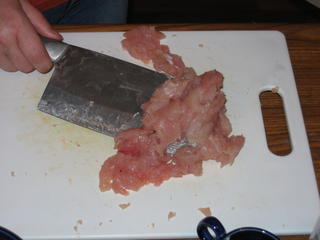
You continue as necessary.
This technique is my preferred method of mincing any meat for Asian foods; grinding meat results in too uniform a result. The hand minced meat comes out with a variety of sized and shaped pieces which add textural interest to any dish in which it is used.
The two strongest flavorings used in the dish appear to be minced Chinese black mushrooms and Sichuan preserved vegetable. I found the mushrooms in all nine of the recipes I surveyed, while the Sichuan preserved vegetable was found in only two, but since I happen to like that flavor, I went ahead and used it. Scallions are commonly used, as is ginger, and in a few recipes, there was some garlic. I used a little bit of scallion and a decent amount of ginger, with only one clove of minced garlic.
The other flavoring ingredient that was universal was Shao Hsing wine or dry sherry, so it was my main liquid flavoring ingredient. I also used light soy sauce, and at the end, sesame oil and the tiniest amount of oyster sauce to impart a whisper of the original, richer recipe that contained oysters.
Finally, there came the matter of adding vegetables. Water chestnuts or bamboo shoots appeared in nearly every recipe. Since I had no fresh water chestnuts, and I will only use canned ones under duress, I used jicama instead, and did not use bamboo shoots. I was interested to see peas in some variety appear in many recipes, though Irene Kuo and Barbara Tropp’s recipes did not use them at all.
I decided to use the sugar snap peas I had in the refrigerator, as well as the last of the fresh baby carrots, to add color and textural interest to the dish, as well as adding a heaping dose of fresh summer sweetness. In addition, I found three small ears of sweet corn in my refrigerator, and cut them from the cob. I adore stir fried fresh corn, and figured that the sweetness of the corn and the texture of it would blend well with the minced chicken.
The finished dish turned out quite well, and though neither Zak nor Dan ate it rolled in the lettuce leaves and instead ate it on top of steamed rice, I found the combination of the cool, crisp leaves and the warm, minced chicken to be outstanding. Instead of the usual iceburg lettuce as most of the recipes called for, I used fresh green leaf lettuce, though I suspect that a nice head of Boston lettuce would yield very pretty curved cup-like leaves that would make lovely individual presentation.
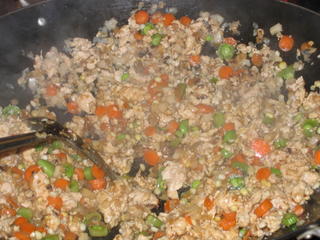
Ingredients:
1 1/2 boneless skinless chicken breasts
3 tablespoons Shao Hsing wine or dry sherry
1 tablespoon light soy sauce
1 teaspoon sugar
2 tablespoons cornstarch
peanut or canola oil for stir frying (about 4 tablespoons)
1 1/2″ cube fresh ginger, peeled and minced
3 scallions, white part only, minced
1 medium garlic clove, minced
2 tablespoons Sichuan preserved vegetable, minced
6 black mushrooms
1 tablespoon soy sauce
1 tablespoon Shao Hsing wine or dry sherry
1/2 cup fresh jicama, peeled and finely diced or chopped (or 6 water chestnuts, peeled and diced)
1/2 cup peeled, sliced baby carrots
1/2 cup stringed, sliced sugar snap peas
3 small ears fresh sweet corn, cut from cob
3 scallion tops, thinly sliced
1 handful cilantro, chopped roughly
1/2 teaspoon sesame oil
1 1/2 tablespoons oyster sauce
Method:
Trim chicken breast pieces of all membranes and fat. Mince as directed above by hand (you can use one cleaver for this–but two are faster), then mix with wine, soy sauce, sugar and cornstarch and allow to marinate while you prepare all other ingredients. (You can also allow it to marinate for several hours, if you want the wine flavor to be stronger.)
Prepare all other ingredients–in order to prepare black mushrooms, rehydrate in warm water to cover. When softened, squeeze out excess water and remove the stem, which is too tough to be used in this recipe. If you wish, you can reserve mushroom soaking liquid and stems to make soup or stock by straining them and putting in the refrigerator, where they will keep a week, tightly covered. Mince the mushroom caps finely.
Heat cast iron or carbon steel wok until it smokes, then add peanut or canola oil. Wait until the oil ripples, then add ginger, scallions and garlic, and stir fry for thirty seconds, or until very fragrant. Add sichuan vegetable and black mushrooms, stir frying for another thirty seconds.
Add marinated chicken, and spread minced chicken over the bottom of your wok and leave it undisturbed for about a minute, to allow it to brown on the bottom. Then, stir fry very vigorously, using chopping motions with your wok spatula in order to get the pieces to stop clinging to each other. When meat is halfway cooked–when half of it is white and half still pink, add soy sauce and wine, and keep cooking. When most of the meat is white, add jicama and carrots, and stir fry thirty seconds, then add snap pea slices and corn, stir frying for another thirty seconds.
Add scallion tops and cilantro, stir well, and if chicken is done, remove from heat. Stir in sesame oil and oyster sauce, then serve on a platter lined with lettuce leaves.
Notes:
There is a classic presentation of this dish which is spicy–to make this dish, use Chinese chili garlic paste to taste and add it with the ginger, scallion and garlic–I would use about a teaspoon to start out with. Or, to preserve the pale color, use minced fresh Chinese or Thai chilies, also added with the ginger, scallions and garlic.
Do not use too much oyster sauce with this dish–you do not want to color the chicken with its dark color, nor do you wish to overpower the fresh flavors in this dish. You want to just add a hint of oceanic oyster flavor. Also use a very good quality oyster sauce–the more expensive brands are more flavorful and less gloopy than the cheaper brands. I like Lee Kum Kee Premium Oyster Sauce, myself.
NanoFood?
So, I come back from a wedding spent on a farm in West Virginia where goats, ponies, turkeys, pheasant and rabbits frolicked and huge kitchen gardens produced enough vegetables and fruits for several families, where wild berries grew juicy and sweet in the shade of towering maples and oaks, to see an email that Zak sent me this morning, pointing me to this story from Alternet:
“The Evolution of Frankenfoods?”.
The culture shock is a bit much for me, but I decided that this was an important enough story to share with my readers.
The headline is a bit misleading: one would assume that the subject of the story was the further exploits of the genetically-modified food industry, which has thus far managed to taint a large number of maize varieties. This happened all because some fancy scientist never bothered to realize that corn is pollinated by the wind, and so promised that thier genetically modified varieties would never come into contact with non-modified varieties because they would be planted far from each other.
Any competent farmer could and would have told them not to underestimate the power of the wind to move corn pollen. (That said, I want to point out that I am not completely against the idea of genetically modified food crops in theory–all food plants and animals have been genetically modified by human beings since the dawn of history, all to the benefit of humankind. What I am against, however, is the use of genetic manipulation of crop plants and animals in order to provide a business monopoly that effectively could land the control of our food supply squarely in the hands of corporate interests. To me, this is the use of a technology that has great potential to benefit all of humanity to only line the pockets of those who are already quite rich by taking advantage of farmers and consumers.)
At any rate–this article, while it does touch on the issue of genetically modified crops, is primarily about the nascent development of nanotechnology. According to the article, very few people know what nanotech actually is, so here is a quick definition, gleaned from the article:
“Definitional confusion is endemic to new technologies, and nanotech is plagued by more than its share of misunderstanding. On the one hand, “nano” refers to any process that takes place at the nano-scale, which is 1-100 nanometers. A nanometer is one-billionth of a meter or one-thousandth the diameter of a human hair. A great deal of chemistry takes place at this level. Even ordinary combustion produces nanoparticles, whether from diesel engines or just plain campfires.
Strictly speaking, though, nanotechnology refers to scientific manipulations at the nano-scale. In the last twenty years, scientists have learned how to manufacture so many different synthetic nano-materials that they now have what amounts to a Lilliputian Lego set. These materials go by often fanciful names such as buckyballs (60 carbon atoms shaped like a mini-soccer ball), dendrimers (molecules that branch like trees), and quantum dots (semiconductor nano-crystals). The variety of these new materials is so wide that it can be difficult to generalize about their properties, just as it would be foolish to generalize about apples and oranges simply because they are both fruit.”
Essentially, in layman’s terms, nanotechnology is the production of and use of machinery on the molecular level in order to manipulate processes and produce chemical and physical change in existing materials that cannot happen in any other fashion. The applications of nanotechnology are seemingly limitless, and have been the stuff of science fiction literature, movies and television ever since the late 1950’s.
However, it is the applications in relation to food that this article primarily focuses upon, which is why I am featuring it in today’s first blog entry.
Here is another excerpt which comes to the crux of why those of us who are concerned with the human food supply should take it upon ourselves to learn about nanotechnology and keep a sharp eye on this, as yet, unregulated industry:
“The last two years have witnessed a flurry of studies suggesting that nanotechnology is not as benign as first thought. This research has shown that carbon nanotubes have caused lung damage in mice, and can, in large quantities, penetrate human skin to cause irritation. Buckyballs have caused brain damage in fish, might knock out smaller links in the aquatic food chain, and turn out to unexpectedly dissolve in water(which might inhibit the growth of important soil bacteria). Derimbers, used in drug delivery ssystems can punch tiny holes in and ultimately destroy cell membranes.
At the other end of the chain, the “end of life” question, no one really knows what happens to nanoparticles. “What happens to all that nano-sized titanium oxide in skin care products when you wash it off?” Rejeski wonders. No one knows if nanoparticles accumulate in human tissue or ecosystems and whether nano-pesticides might pose some future DDT-like problem.”
In essence, what we have is an untested, unregulated series of processes, which have unlimited applications in industry, agriculture, and medicine, which most of humanity knows nothing about. However, please take note of which food corporations are funding research into nanotechnological applications in food production: Kraft, Syngenta and Monsanto–all leaders in food processing, the gentic modification of crops or the manufacture of pesticides and herbicides.
Nanotechnology stands poised to make the leap from science fiction to reality within the next couple of decades, and has the potential to completely change the ways in which humans eat, both for good and ill, as well as how we relate to all aspects of life. It is being marketed to investors as a chance to maximize profit, and the governments of the world are lagging behind in regulating its growth and application, even though serious questions about its safety to humanity and the biosphere remain unanswered.
For further information, check out The Center for Responsible Nanotechnology website and the blog, Responsible Technology.
Also, look at Harold Lovy’s excellent, but no longer active, blog, NanoBot–he has some great commentary on both the positive and negative aspects of the nanotechnology question.
Powered by WordPress. Graphics by Zak Kramer.
Design update by Daniel Trout.
Entries and comments feeds.


